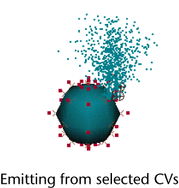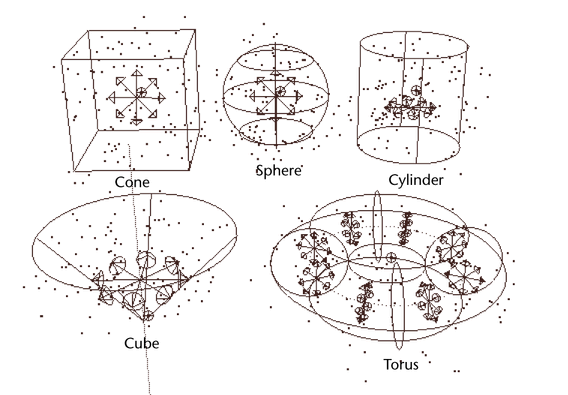The following procedures describe how to create emitters with default settings. For details on other settings, see Set emitter attributes by typing entries. In the following procedures, you must play the animation as the final step to see the particles emit.
You cannot add an emitter to an object if the emitter already has some other technique controlling its translate attributes. Furthermore, after you add an emitter to an object, you cannot control the emitter’s translate attributes with another technique, for example, an expression.
If you select only some of an object’s CVs, vertices, or particles, the emitter applies only to those selected.
To emit particles from points on a surface
 to display
the options window.
to display
the options window.
For details on emitting from entire surfaces evenly, see Spread emission more evenly from NURBS surfaces.
To emit particles from points on a curve
 to display
the options window.
to display
the options window.
To emit from all CVs or vertices of a selected object
 to display
the options window.
to display
the options window.
To emit particles from selected vertices, CVs, or edit points
 (the Select
by Component Type icon).
(the Select
by Component Type icon).
 to display
the options window.
to display
the options window.
Adding an emitter to components creates a set of components named for the emitter. You can change the components that emit by editing the set membership (see the Basics guide). Note that you cannot emit from components of an object in a referenced scene.

For example, you can make emitted particles use the attribute values of the emitting particles. You can also use the emit command in an expression to make particles emit at the point where particles die.
For detailed examples of the emit command, see the online MEL Command Reference: Alphabetical.
To emit particles into a volume shape
 .
.

The implicit shape of the volume emitter is displayed on the screen. You can move, rotate, scale, or shear the emitter.
To hide the shape of the volume emitter
To hide the emitter icon that represents the emitter
Sometimes it’s easier to select the emitter in the Outliner. If you are emitting from an object rather than position, the emitter is indented under the object’s name in the Outliner.
 (Windows
and Linux) or
(Windows
and Linux) or  (Mac OS
X).
(Mac OS
X).
When you delete an emitter, the emitted particle object is not automatically deleted. If this particle object isn’t connected to other items in the scene, you can delete it also. Use the Outliner to delete it.